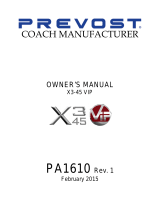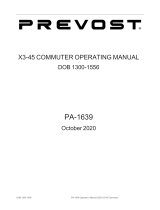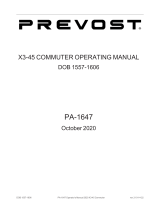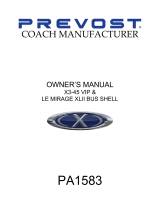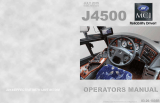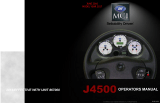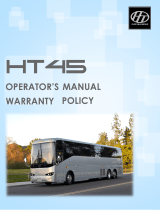Page is loading ...

Owner’S
MANUAL
H3-45 VIP


COACH MANUFACTURER
OWNER’S MANUAL
PA1601 Rev.5
February 2017

PA1601
Featuring:
PRIME (Power Recovery by Intelligent Management of Energy) and
Bitzer A/C Compressor
First edition: April 2013, starting from vehicle D-2364
REV
EFFECTIVE
DESCRIPTION
DATE
1
E-2602
Allison transmission 5th Generation, GHG14
August 2014
2
3
F-2929
G-3185
New Keyless Entry System
New Engine Brake
Feb. 2015
Dec 2015
4
5
H-3645
H-3735
New Prevost Slide-Out with Flush Floor
GHG17 Motor, Telematics device note added
Nov. 2016
Feb 2017

FOREWORD i
This PREVOST Private Coach Owner's Manual
has been prepared to thoroughly acquaint you,
the owner, with vehicle equipment and features
in order to fully appreciate and safely enjoy your
vehicle. Of course, you are anxious to drive your
new private coach and test its features, but first
please read this publication carefully to help
ensure enjoyable and trouble free operation.
This book should be kept inside the vehicle at all
times for convenient reference. It is also
suggested that it remains with the vehicle at the
time of resale. Please notify PREVOST CAR
INC. when the vehicle's ownership is transferred
so that our records can be kept up to date. Do
this by filling out the appropriate form at the end
of this manual.
The specifications, descriptions and figures
given are based on the latest information
available at printing time. And because at
PREVOST we are constantly striving to improve
our products, we reserve the right to make
changes at any time without notice and/or
obligation on our part.
Please note that this publication applies to
factory-prepared, conversion-ready luxury
private coaches, manufactured by PREVOST
CAR INC. It describes and explains the
equipment and options available for installation
in our factory. Therefore, there may be
equipment described herein that is not installed
on your vehicle. This publication also does not
cover equipment installed by your interior
designer or system manufacturer.
This manual, or portions thereof, cannot be
reproduced in any form whatsoever, in whole or
in part, without the written consent of PREVOST
CAR INC.
The following words are used to emphasize
particularly important information:
WARNING
Identifies instructions which, if not followed,
could result in serious personal injury or loss
of life.
CAUTION
Denotes instructions which, if not followed,
could cause serious damage to vehicle
components.
NOTE
Indicates supplementary information needed
to fully understand and complete an
instruction.
For your own safety and to ensure prolonged
service life of your private coach, heed our
cautions, warnings and notes. Ignoring them
could result in extensive damage and/or serious
personal injury.
Note: Illustrations in this manual are used for
reference only and may differ slightly from the
actual vehicle; however, key components
addressed in the manual are represented as
accurately as possible.

ii FOREWORD
CRITICAL EMISSION-RELATED MAINTENANCE
Source of parts and repair:
A repair shop or person of the owner’s choosing must maintain, replace, or repair emission control
devices and systems per manufacturer's recommendations.
Replacement of tires that are GHG certified:
The original equipment tires installed on this vehicle at the factory were certified to the U.S. EPA
Greenhouse Gas (GHG) and National Highway Traffic Safety Administration (NHTSA) Fuel
Efficiency regulations. Replacement of these tires should
be with
a tire of equal or lower rolling
resistance levels (TRRL or Crr). Please consult your tire supplier(s) for appropriate replacement tires.
Maintaining a GHG certified tire:
In order to maintain the certified rolling resistance of the tires which optimize fuel economy, the
maintenance procedures provide by the tire manufacturer must be followed.
EVENT DATA RECORDING DEVICES
This PREVOST vehicle is equipped with a device generally referred to as an "event data recorder" or
"EDR." Please note that while the term "event data recorder" is typically used throughout the motor
vehicle industry, not every EDR is the same; i.e., they do not all record the same data elements.
The EDR on this PREVOST vehicle records vehicle speed, engine RPM, time and date, plus a variety of
pedal and switch positions, both before and after an "event." Sudden vehicle deceleration or the
occurrence of certain other vehicle operational characteristics will define (trigger) an "event."
For any questions about this vehicle EDR device, contact a PREVOST Service Center or a regional
service manager.

FOREWORD iii
iii
TELEMATICS DEVICE
Your vehicle is equipped with one or more recording devices (“Telematics Device”), associated with
Prevost’s Connected Vehicle Services (the “Telematics Services”). These services, which are described
in greater detail at www.prevostcar.com (the “Website”), allow you to manage vehicle maintenance and
repair in a cost-effective manner by providing: proactive diagnostic and repair planning assistance with
detailed analysis of diagnostic trouble codes; streamlined service procedures with parts-on-hand
confirmation before a vehicle arrives for service; and live repair and customer communication. The
service eliminates or reduces diagnostics time, enhances repair efficiency, expedites decision process,
improves communications and maximizes uptime. To access the Telematics Services, you must enter
into a Telematics Subscription Agreement with Prevost, via the sales agreement pertaining to your
vehicle.
The Telematics Device collects stores and/or transmits information about your vehicle. Such information
may include direction and rate of speed, fuel consumption, engine performance, gearing, rpm, altitude,
geo-location (including a history of where the vehicle travels), safety information related to the use and
operation of the vehicle, vehicle performance, diagnostic data and error codes. The Telematics Device
has the capacity to store historical data about the use and performance of your vehicle. The Telematics
Device has the ability to transmit information to a central communications system. The information
contained in your Telematics Device may be periodically transmitted to or accessed by Prevost and
others authorized by Prevost, along with your vehicle’s VIN number or other identifying information.
Prevost does not collect any driver information. Prevost retains and uses this information to understand
the operational use of your vehicle, to remotely tune your vehicle, and to help facilitate maintenance and
vehicle improvements. To the extent allowed by law, Prevost reserves the right to access, use and control
this information.
Declining to enter into a Telematics Subscription Agreement with Prevost, or canceling a Telematics
Subscription Agreement, will not end the transmission of data from your Telematics Device or the
collection of information by Prevost. Prevost may access Telematics Data, to the extent it is available, and
use it in connection with providing services and vehicle improvements to you and your vehicle. Prevost
will regularly purge from its systems all data collected from your Telematics Device, at time intervals
determined by Prevost at its sole discretion.


TABLE OF CONTENTS iv
SECTION 1 SAFETY PRECAUTIONS .............................................................................................. 1-1
SECTION 2 VEHICLE EXTERIOR .................................................................................................... 2-1
SECTION 3 VEHICLE INTERIOR ..................................................................................................... 3-1
SECTION 4 CONTROLS AND INSTRUMENTS ............................................................................... 4-1
SECTION 5 OTHER FEATURES ...................................................................................................... 5-1
SECTION 6 STARTING AND STOPPING PROCEDURES .............................................................. 6-1
SECTION 7 SAFETY FEATURES AND EQUIPMENT ..................................................................... 7-1
SECTION 8 CARE AND MAINTENANCE ........................................................................................ 8-1
SECTION 9 TECHNICAL INFORMATION ........................................................................................ 9-1
ABBREVIATIONS
APPENDIX A – SERVICE LITERATURE
APPENDIX B – TROUBLESHOOTING MULTIPLEX
APPENDIX C – ALLISON DIAGNOSTIC TROUBLESHOOTING CODES
APPENDIX D – TPMS TROUBLESHOOTING GUIDE


SAFETY PRECAUTIONS 1-1
SECTION 1 SAFETY PRECAUTIONS
SAFE OPERATING PRACTICES ................................................................................................................ 2
DEFENSIVE DRIVING PRACTICES ............................................................................................................ 2
OTHER PRECAUTIONS .............................................................................................................................. 3

1-2 SAFETY PRECAUTIONS
SAFE OPERATING PRACTICES
To ensure safe and reliable operation, heed the
following safety precautions.
o Operation and maintenance of the vehicle
must be performed only by qualified
personnel.
o Before driving, conduct a walk around
inspection and check that all baggage
compartment doors and equipment access
doors are securely shut.
o Make sure good visibility is maintained at all
times. Keep windshields clean and free of
obstructions.
o Adjust the driver's seat so that all controls
can be reached easily.
o Always wear your safety belt when driving.
o Check the instrument panel frequently. Do
not operate the vehicle when dials or
indicators do not indicate normal operating
conditions.
o Always pay attention to pedestrians passing
in front and behind the vehicle. Always yield
to pedestrians at pedestrian walkways.
o Do not drive over obstacles on the road.
Empty boxes, piles of leaves, and snowdrifts
could conceal hidden dangers that could
damage the vehicle suspension and
underbody.
o When turning or changing lanes, signal your
intention well in advance.
o When approaching to make a right turn,
reduce the space between the vehicle and
the curb to make sure another vehicle
cannot pass on the right. Since the vehicle
makes wide turns, allow enough space to
make safe turns.
o Switch from high beams to low beams when
meeting or following other vehicles within
500 feet (150 meters).
o Never leave the vehicle unattended with the
engine running or with the key in the ignition.
Turn off the engine, remove keys and apply
the parking brake before leaving the vehicle.
o Shut-off the engine before refueling, adding
oil, performing maintenance or servicing
tasks, unless stated otherwise.
o Fuel is highly flammable and explosive. Do
not smoke when refueling. Keep away from
open flames or sparks.
o Do not run the engine or HVAC system with
access doors left open. Close compartment
doors before operating any equipment.
o Do not remove the surge tank filler cap or
the cooling system pressure cap when the
engine is hot. Let the engine cool down
before removing filler caps.
o Do not attempt to push or pull-start the
vehicle.
o The service life of the vehicle depends on
the kind of maintenance it receives. Always
record any problems and report them
immediately to maintenance personnel. After
each trip, perform a system diagnostic to
check if error codes and anomalies were
recorded in the vehicle electronic modules.
DEFENSIVE DRIVING PRACTICES
o For city driving, allow a four to six second
travel interval between your vehicle and the
vehicle ahead. Increase this travel interval
to six to eight seconds for highway driving.
Increase time interval for driving at night or
in foul weather.
o Be prepared to stop when approaching an
intersection. The stopping distance of the
vehicle increases with the weight and speed.
o Establish eye-to-eye contact with other
drivers and with pedestrians. Use, high
beam and low beam headlights, turn signals
and horn as needed.
o On highway, don't stare at the road ahead.
Keep your eyes moving. Check mirrors and
dashboard instruments frequently.
o To keep the vehicle from drifting across
lanes during highway driving, always look
over the horizon on the road ahead.
o Adjust your speed to road conditions, traffic
and visibility. Never exceed the posted
speed limits.
o If another vehicle is following close behind,
reduce your speed to let the vehicle pass.
For additional information about safe operation
and defensive driving practices, contact the local
department of motor vehicles authority.

1-3 SAFETY PRECAUTIONS
OTHER PRECAUTIONS
WARNING
Prior to working on a system inside vehicle,
make sure to cut electrical power and air
supply. A component could be supplied with
electricity even if the ignition switch is set to
the OFF position and/or a component could
be pressurized even if air tanks are emptied.
Always refer to the appropriate wiring and
pneumatic diagrams prior to working on
electrical and/or pneumatic systems.
WARNING
CALIFORNIA PROPOSITION 65:
Diesel engine exhaust and some of
its
constituents are known to the State of
California to cause cancer, birth defects and
other reproductive harm.
Battery posts, terminals and other related
accessories contain lead and lead
compounds, chemical known to the State of
California to cause cancer and other
reproductive harm.
Batteries also contain other chemicals known
to the State of California to cause cancer.
Wash hands after handling.
NOTE
When the ignition switch is set to the OFF
position, the electrical components are not
energized except for the CECM (Chasis
Electronic Control Module), the battery
equalizer, the preheater system and some
electronic modules; which are energized during
15 minutes after the ignition has been set to
the OFF position. Prior to working on one of
these electrical components, set the battery
master switch in the main power compartment
to the OFF position. If the vehicle will not be
operated for a long period (more than 2
weeks), it is recommended, in order to prevent
the batteries from discharging, to trip the main
circuit breakers located in the main power
compartment to stop the small current drawn
by the radio preset station memory, the CECM
memory and the instrument cluster clock. Note
that the radio station presets will be erased,
same thing for the diagnostic codes history and
the instrument cluster clock will have to be
reset.
CAUTION
Prior to arc welding on the vehicle, refer to
section 00-GENERAL of your maintenance
manual. Precautions have to be taken to
avoid costly damage to the electronic
components.


VEHICLE EXTERIOR 2-1
SECTION 2 VEHICLE EXTERIOR
EXTERIOR VIEW ...................................................................................................................................................... 2
ENGINE COMPARTMENT CURBSIDE DOOR .................................................................................................... 3
ENGINE COMPARTMENT DOOR ......................................................................................................................... 3
DPF ACCESS DOOR .................................................................................................................................................. 4
MAIN POWER COMPARTMENT (BATTERY) .................................................................................................... 4
ENGINE RADIATOR DOOR .................................................................................................................................... 5
SCR CATALYTIC CONVERTER ACCESS HATCH ............................................................................................ 5
CONDENSER COMPARTMENT (WITH OPTIONAL CENTRAL A/C SYSTEM) .......................................... 5
EVAPORATOR COMPARTMENT (WITH OPTIONAL CENTRAL A/C SYSTEM) ....................................... 6
FRONT ELECTRICAL AND SERVICE COMPARTMENT................................................................................. 7
RECLINING BUMPER COMPARTMENT............................................................................................................. 7
BAGGAGE COMPARTMENTS ............................................................................................................................... 7
FUEL AND DIESEL EXHAUST FLUID (DEF) FILLER NECK ACCESS DOOR ............................................. 8
ENTRANCE DOOR .................................................................................................................................................. 8
INSIDE OPERATION ............................................................................................................................................... 8
OUTSIDE OPERATION ........................................................................................................................................... 9
KEYLESS ENTRY SYSTEM ................................................................................................................................... 9
EXTERIOR REAR VIEW MIRRORS ...................................................................................................................... 9
ELECTRICALLY ADJUSTED MIRROR ................................................................................................................ 9
RETRACTABLE BACK-UP CAMERA ................................................................................................................. 10
120 VOLTS CONNECTOR ...................................................................................................................................... 10
TRAILER HITCH ....................................................................................................................................................... 10

2-2 VEHICLE EXTERIOR
EXTERIOR VIEW
H3-45 VIP EXTERIOR VIEW 18688
1. Engine air intake
2. Engine R.H. side access door
3. Main power compartment
4. Baggage compartment
5. Fuel filler neck access door
6. A/C condenser compartment or baggage
compartment
7. Entrance door
8. Retractable back up camera (optional)
9. Diesel Particulate Filter (DPF) access door
10. Engine compartment rear door
11. Rear-view mirror
12. Reclining bumper compartment
13. Front electrical and service compartment
14. Driver’s power window
15. Heating, ventilating and air conditioning
compartment (HVAC) or baggage
compartment
16. Fuel filler neck and diesel exhaust fluid
(DEF) filler neck access door
17. Auxiliary axle
18. Engine radiator door
19. SCR catalytic converter access door

VEHICLE EXTERIOR 2-3
ENGINE COMPARTMENT CURBSIDE
DOOR
Lock this door using the
exterior compartment key.
Lift up protector cover to
gain access to the lock.
Pull up the door handle to
release the latch and then
pull the door open.
The curbside door has a safety catch on top to
prevent it from closing inadvertently. Release the
safety catch before closing the door.
DOOR HANDLE 18184
The engine compartment curbside door provides
access to the following (if equipped)
Engine compartment rear door release lever
Fuel Pro 382 filtration system (optional)
Primary and secondary air system fill valve
Booster block terminals
Wet air tank drain valve
Engine air filter
Engine block heater connector
Power steering fluid reservoir
Battery charger 110-120 volts connector
WARNING
Unless otherwise stated, do not run the engine
when the engine compartment curbside door
is open.
ENGINE COMPARTMENT DOOR
To open engine
compartment door, first
open engine compartment
curbside door. Lift the
latch release lever, place
hand on the upper right of
the rear door and pull
rearward.
Then, using both hands, lift the door up. Always
engage the safety catch when the engine
compartment rear door is open. Release the
catch before closing the door.
The lighting in the engine compartment turns on
automatically when that door is open if the
engine compartment light switch is set to ON
and the ignition key is set to ON or ACC. Use
this switch to turn off the light if it is not required
when the door is open for an extended period.
When open or not closed properly, an
annunciator pictogram will appear on the
instrument cluster DID. To close the door, lift it
slightly and release the safety catch.
OPENING THE ENGINE COMPARTMENT DOOR 18331
The engine compartment rear door provides
access to the following:
Engine
Alternators
Compressors
Belt tensioner control valve (see Care and
Maintenance chapter)
Starter selector switch (see Starting and
Stopping Procedures chapter)
Engine cooling fluid surge tank and filler cap

2-4 VEHICLE EXTERIOR
Engine air filter restriction indicator
Engine oil dipstick
Engine oil filler cap
Allison transmission oil dipstick & filler tube
WARNING
Pressurized cylinders assist the engine
compartment door opening. To avoid injury,
stand clear when opening the engine
compartment rear door.
WARNING
Unless otherwise stated, avoid running the
engine when the engine compartment door is
open.
DPF ACCESS DOOR
The engine door must be
open before opening the
diesel particulate filter
access door. To open the
DPF access door, press
the latch release lever.
Using both hands, push
the door up until it locks in
place.
To close the door, press the latch release lever
again and lower the door, holding it with both
hands.
WARNING
Proceed with extreme care when opening the
DPF access door. Hold the door with both
hands and never place your fingers behind the
door panel.
DIESEL PARTICULATE FILTER ACCESS DOOR
MAIN POWER COMPARTMENT
(BATTERY)
To unlock the main power
compartment door, use
the exterior compartment
door key. The door will
pop open.
The lighting in the compartment turns on
automatically when the door is open if the ignition
key is set to ON or ACC. When the main power
compartment door is open, an annunciator
pictogram appears on the instrument cluster
DID.
The main power compartment provides access
to the following:
(4x) 12-volt batteries
12-volt and 24-volt electrical systems main
circuit breakers for
Battery charger (optional)
Vanner battery equalizer
Battery master switch
Transmission Electronic Control Unit (TECU)
Multiplex modules: I/O-A, I/O-B
Rear fuse box (VECR) & spare fuses
Relays and diodes
Electronic ground stud
PARTIAL VIEW OF MAIN POWER COMPARTMENT

VEHICLE EXTERIOR 2-5
MAIN CIRCUIT BREAKERS 12-VOLT & 24-VOLT 06605A
ENGINE RADIATOR DOOR
Open the engine radiator door by pushing on the
release latch located on the left side, behind the
louvers.
RADIATOR DOOR RELEASE LATCH LOCATION 18529
SCR CATALYTIC CONVERTER
ACCESS HATCH
To gain access to the SCR catalytic converter:
1. Open the radiator door first;
2. Pull the catch connecting rod to unlock the
access hatch;
3. Lift the hatch open;
4. Hold the door open by inserting the support
rod free end into the receptacle located on
the left side of the door.
WARNING
After inserting the support rod into the
receptacle, make sure that the rod supports
the door securely from falling down on to your
head or body.
WARNING
External and internal temperatures remain hot
long after engine has been shutdown. Allow
the aftertreatment device and DPF to cool
before handling. Wear protective clothing and
glove while servicing.
ACCESSING THE SCR CATALYTIC CONVERTER 04035
CONDENSER COMPARTMENT (with
optional central A/C system)
To open the condenser compartment door:
1. Open the fuel filler door first;
2. Move the latch bolt pin to the right as shown
(step 1 on image);
3. Rotate the latch handle as shown (step 2);
4. Open the door on the right side when facing
the door.

2-6 VEHICLE EXTERIOR
A/C CONDENSER COMPARTMENT DOOR OPENING
CONDENSER COMPARTMENT (WITH CENTRAL A/C
SYSTEM, DEF TANK NOT SHOWN) 22362
EVAPORATOR COMPARTMENT (with
optional central A/C system)
Find the evaporator compartment door release
latch on the left wall of the adjacent baggage
compartment. Pull the release latch then pull the
evaporator compartment door open.
The evaporator compartment contains relays,
diodes and an I/O-B multiplex module mounted
on a panel located on the R.H. side wall when
facing the compartment.
EVAPORATOR COMPARTMENT ACCESS 18306
EVAPORATOR COMPARTMENT (WITH CENTRAL A/C
SYSTEM ONLY) 22365
HVAC COMPONENTS PANEL 06596B
NOTE
It is important to keep the evaporator
compartment door closed while checking the
HVAC system to prevent faulty readings.
/



